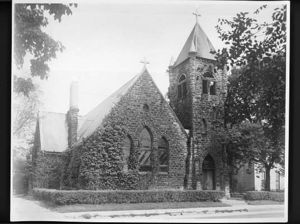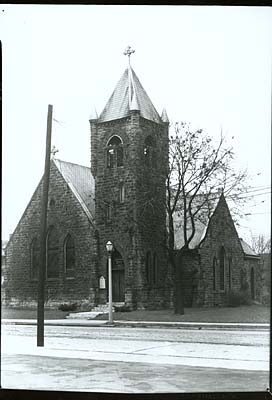Gethsemane Episcopal Church
Contents
Construction
The group of Episcopalians decided to erect a church at 9th and Washington. Philip P. Patton was contracted to build the church for the sum of $3,741.00 for the woodwork and $2,425.80 for the stonework. The architect was Arthur Labelle of the Labelle & French office in Marion (Chronicle Tribune 1876). Easter morning found a new rector in Marion; the Reverend Lewis F. Cole then became director of Gethsemane. On June 2, 1890, they broke ground to begin building the church. Bishop Knickerbacker laid the corner Stone on July 23, 1890. In the corner stone were placed copies of the local newspaper and the Gethsemane newsletter, “The Living Church.” (History of Gethsemane 4). Gethsemane was completed and first opened its doors for worship on October 4, 1891 (History of Gethsemane 4).
Design Features
The church has a Gothic design that makes it unique. The church is in the shape of a huge cross, the altar is in the “top of the cross.” The walls behind the altar are in the shape of a boat hull. The reason for this design was so that the priest could be heard well. Back when the church was built the altar was on the back wall facing the exterior of the church. During the sermon the priest would face that back wall. His voice then would have followed the wall and projected out into the congregation. In front of the altar, there is a crossbeam which is known as a rude beam. This beam was traditonally used when churches had no doors and the animals had to be kept away from the altar. They accomplished that by putting in gates. No longer needed to keep out wandering beasts, it is used for architectural purposes. On the ceiling there are cross buttresses that extend from one wall to the other. In the back of the church there is a balcony where the choir sits and sings. The exterior of the church is made of sandstone, which will not last as long as if it were limestone but is still good. The tower of the church, which holds the bell, is between 70 and 80 ft. tall.
Early Years of the Church
Father Lewis Cole was the rector and the only clergyman present on the day of its opening. During the next few years Father Cole took all the pews and baptismal font out of the nearby prayer house on what is now now the 500 block of Washington Ave. was known as “Webster’s Chapel” and put in them in the church so the church would be complete. He stayed at the church for three and a half years. The First marriages recorded in the church were that of Harry M. Gifford and Jessie McAllister on June 22,1893. Lewis F. Cole resigned as rector of the church to become Archdeacon of the diocese. Rev. J.J. Purcell became the rector of the church on November 7, 1893. During this time Miss Julia Norton made a contribution to the church in the sum of over one thousand dollars. Her brother contributed some property that would later be used as the rectory. The rector of the church would live in this house with his family and get paid a salary of $1200.00.
During this period Frank A. Cole, son of the rev. Cole became the Clerk of the Vestry. During this time the historical notes of the church slowed down a bit and no records were found between the years of 1897 through 1901. In the may of 1904 the Archdeacon Torrence resigned as archdeacon and came to work in the parish. During that year 1904 Col. O.H.P. Carey died and left the church some valuable real Estate that the church sold for a sum of $3321.32, which went to the Carey fund and $27.44 deposited in the bank. On February 13, 1905, the vestry decided to fix the Rectory to an extent of $800.00. A new roof was put on the Rectory and plans were made for installing a steam heating system. August 6, 1906, the vestry divided the rector’s time between St. Paul’s, Gas City, therefore reducing the cost of the expenses by $300.00. In October of 1908 the expenses of the choir were cut and the choir was reduced to volunteers. The vestry felt the need for a Parish House, in which to carry on various activities. On November 10, 1909, the vestry considered the purchase of the house north of the church. Using the Mary A. Carey fund, which was a great step for the church, made this purchase (History of Gethsemane 4-9).
On February 14, 1910, the resignation of the Rev. George P. Torrence was presented and the resignation was to take place on Easter day. Thereafter he left to go work at St. John’s church in Lafayette, Indiana. On March 7, 1910, Gethsemane and St. Paul’s voted to call the Rev. H.R. White of Chicago, to become rector of these two churches. The new rector did a good job with the two churches but was terminated in the summer of 1912. The new rector would be the Rev. F. B. B. Johnston; he began on March 1, 1913. He had a plan to bring in more music by purchasing a new pipe organ that would help liven up the services; the organ was purchased for $1800. The Organ was at the front of the church of to the left of the alter where it stayed for many years. In the year 1920 the church decided to buy the property south of the church and build a parish house. The Rectory was then sold for $4000 and the parish house cost $5000 to build.
Additions and Improvements
In the 1950’s a new Parish house was built that connected to the church and was newer than the old house that was used for functions. This house held the bible classes and the Sunday schools in the basement. Activities were held in the parish house and it was used as a church gathering place. The church slowed down from the 50s to the 90s in enthusiasm and records of the church slowed down also.The church had been remodeled four times. The most recent one started in October of 1994 and was rededicated on January 6th 1995. The whole church was retiled and new carpeting was put in, also it was completely painted with modern lighting put in. At this time the church is starting to replace all the stained glass windows. The senior warden of the vestry at that time was Bill Munn and the chairman of the restoration committee was Randy Powers. This remodeling was done because “We have a commitment to remain in Central Marion,” said Bill Munn. (“Church Pleased with Renovation”)
The church has gone through many years and many different generations that had made it a unique structure in Marion. The people of the church have been faithful for most of their lives trying to improve the quality of this fine church and succeeding making it still prosperous and spiritual. The building is still one of the oldest in Marion and has been very useful to the community of Marion. The church will last for a long time to come and the building is in great structural condition.
Works Cited
- Chronicle Tribune 6 Apr. 1876, Daily Ed.
- History Of Gethsemane Church. Marion, 1939, 1-17.
- Roby, Shelby. “Church Pleased With Renovation.” Chronicle-Tribune 6 Jan. l995, Daily Ed.: C1+.
Credits
This article was written by Matthew Powers and submitted on January 16, 2001.

